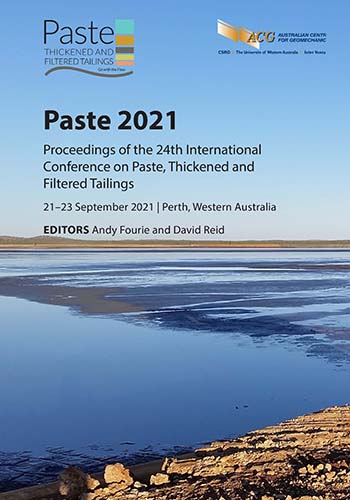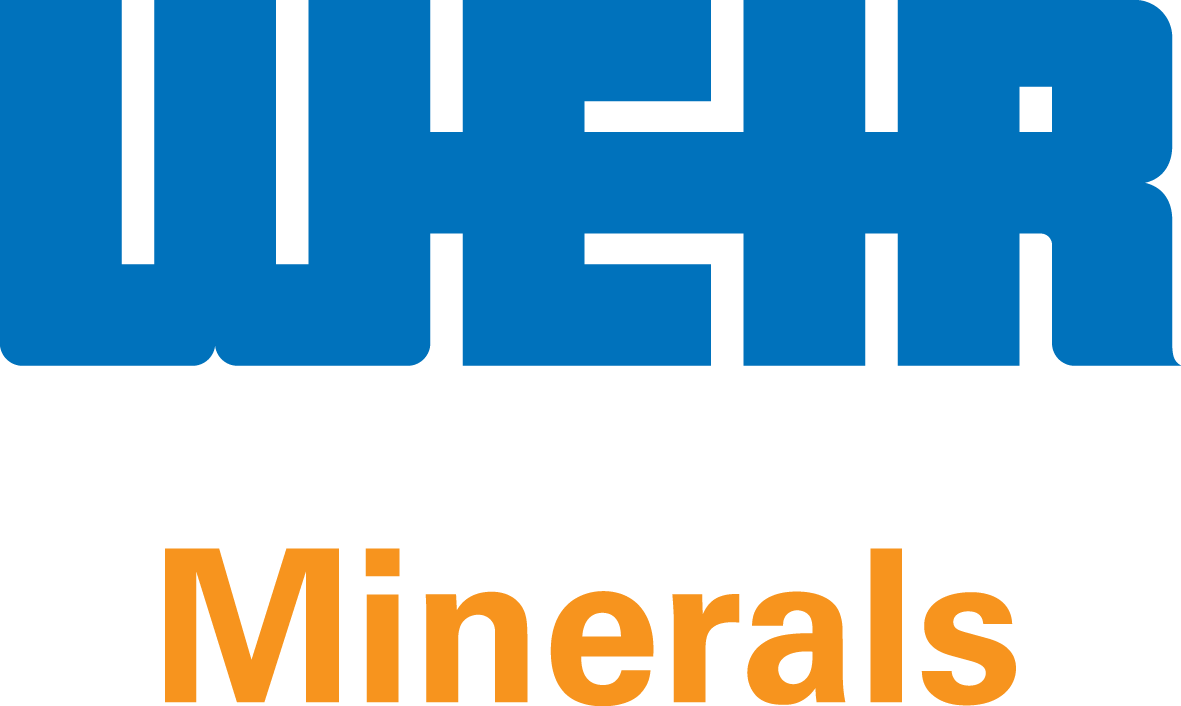Strain localisation behaviour of cemented paste backfill

|
Authors: Zhao,Y; Guo, LJ; Taheri, A; Karakus, M; Deng, A |
DOI https://doi.org/10.36487/ACG_repo/2115_30
Cite As:
Zhao,Y, Guo, LJ, Taheri, A, Karakus, M & Deng, A 2021, 'Strain localisation behaviour of cemented paste backfill', in AB Fourie & D Reid (eds), Paste 2021: Proceedings of the 24th International Conference on Paste, Thickened and Filtered Tailings, Australian Centre for Geomechanics, Perth, pp. 369-380, https://doi.org/10.36487/ACG_repo/2115_30
Abstract:
Mine tailings are the most significant and most problematic sources of solid waste globally in the mining industry. The developing concept of sustainable mining warrants reusing mine wastes, particularly tailings. Cemented paste backfill (CPB) is a backfill method composed of dewatered tailings, a cementitious binder, and processed mine water. CPB reuses tailings in underground mine excavations, and as such, reduces the amount of surface-disposed tailings, mitigates the potential environmental impacts, and assists waste management. In this study, the strain localisation behaviour of a South Australian copper–gold underground mine CPB system was evaluated through a comprehensive experimental programme. Understanding the strain localisation behaviour helps evaluate CPB damage evolution and failure mechanism under real-life loading regimes. The three-dimensional digital image correlation (DIC) technique was used to measure the full-field of strain development on the surface of CPB samples during unconfined compressive strength (UCS) tests. With the use of several virtual extensometers, the axial and lateral strains of CPB samples, with and without strain localisation, in both pre-peak and post-peak regimes are characterised. Overall, the DIC technique provides more accurate stress–strain relations of CPB samples than conventional external measurement devices. The DIC test results indicate that strain localisation of CPB samples initiates in the prepeak regime at around 80% of the UCS. The greater the binder content and the longer the curing time, the higher the axial stress level required to initiate localisation to the UCS, thus emulating the failure mechanism of quasi-brittle materials – rock and concrete. Finally, with the increase of curing time, the difference between strain values at the localised and non-localised zones became less significant in the prepeak regime and more pronounced in the post-peak regime.
Keywords: tailings, cemented paste backfill, digital image correlation, strain localisation
References:
Dai, S, Liu, X & Nawnit, K 2019, ‘Experimental study on the fracture process zone characteristics in concrete utilising DIC and AE methods’, Applied Sciences, vol. 9, no. 7,
del Rey Castillo, E, Allen, T, Henry, R, Griffith, M & Ingham, J 2019, ‘Digital image correlation (DIC) for measurement of strains and displacements in coarse, low volume-fraction FRP composites used in civil infrastructure’, Composite Structures, vol. 212, pp. 43–57,
Fall, M, Célestin, JC, Pokharel, M & Touré, M 2010, ‘A contribution to understanding the effects of curing temperature on the mechanical properties of mine cemented tailings backfill’, Engineering Geology, vol. 114, no. 3–4, pp. 397–413,
Gencturk, B, Hossain, K, Kapadia, A, Labib, E & Mo, Y-L 2014, ‘Use of digital image correlation technique in full-scale testing of prestressed concrete structures’, Measurement, vol. 47, pp. 505–515,
Jones, H & Boger, DV 2012, ‘Sustainability and waste management in the resource industries’, Industrial & Engineering Chemistry Research, vol. 51, no. 30, pp. 10057–10065,
Li, W & Fall, M 2018, ‘Strength and self-desiccation of slag-cemented paste backfill at early ages: link to initial sulphate concentration’, Cement and Concrete Composites, vol. 89, pp. 160–168,
Liu, G, Li, L, Yang, X & Guo, L 2017, ‘Numerical analysis of stress distribution in backfilled stopes considering interfaces between the backfill and rock walls’, International Journal of Geomechanics, vol. 17, no. 2,
Mao, L, Liu, H, Zhu, Y, Zhu, Z, Guo, R & Chiang, F 2019, ‘3D strain mapping of opaque materials using an improved digital volumetric speckle photography technique with X-ray microtomography’, Applied Sciences, vol. 9, no. 7,
app9071418
Munoz, H & Kiyota, T 2020, ‘Deformation and localisation behaviours of reinforced gravelly backfill using shaking table tests’, Journal of Rock Mechanics and Geotechnical Engineering, vol. 12, no. 1, pp. 102–111,
Munoz, H & Taheri, A 2017, ‘Local damage and progressive localisation in porous sandstone during cyclic loading’, Rock Mechanics and Rock Engineering, vol. 50, no. 12, pp. 3253–3259,
Munoz, H & Taheri, A 2019, ‘Postpeak deformability parameters of localised and non-localised damage zones of rocks under cyclic loading’, Geotechnical Testing Journal, vol. 42, no. 6,
Munoz, H, Taheri, A & Chanda, EK 2016, ‘Pre-peak and post-peak rock strain characteristics during uniaxial compression by 3D digital image correlation’, Rock Mechanics and Rock Engineering, vol. 49, no. 7, pp. 2541–2554,
Naganathan, S, Razak, HA & Hamid, SNA 2012, ‘Properties of controlled low-strength material made using industrial waste incineration bottom ash and quarry dust’, Materials & Design, vol. 33, pp. 56–63,
j.matdes.2011.07.014
Nguyen, TL, Hall, SA, Vacher, P & Viggiani, G 2011, ‘Fracture mechanisms in soft rock: identification and quantification of evolving displacement discontinuities by extended digital image correlation’, Tectonophysics, vol. 503, no. 1–2, pp. 117–128,
Oka, F, Shahbodagh, B & Kimoto, S 2018, ‘A computational model for dynamic strain localisation in unsaturated elasto‐viscoplastic soils’, International Journal for Numerical and Analytical Methods in Geomechanics, vol. 43, no. 1, pp. 138–165,
Orejarena, L & Fall, M 2010, ‘The use of artificial neural networks to predict the effect of sulphate attack on the strength of cemented paste backfill’, Bulletin of Engineering Geology and the Environment, vol. 69, no. 4, pp. 659–670,
Panteleev, I, Plekhov, O, Pankov, I, Evseev, A, Naimark, O & Asanov, V 2014, ‘Experimental investigation of the spatio-temporal localisation of deformation and damage in sylvinite specimens under uniaxial tension’, Engineering Fracture Mechanics, vol. 129, pp. 38–44,
Qian, G, Huang, T & Bai, S 2011, ‘Use of cement-stabilised granite mill tailings as pavement subbase’, Journal of Materials in Civil Engineering, vol. 23, no. 11, pp. 1575–1578,
Rankine, RM & Sivakugan, N 2007, ‘Geotechnical properties of cemented paste backfill from Cannington Mine, Australia’, Geotechnical and Geological Engineering, vol. 25, no. 4, pp. 383–393,
Shadmehri, F & Hoa, SV 2019, ‘Digital image correlation applications in composite automated manufacturing, inspection, and testing’, Applied Sciences, vol. 9, no. 13,
Sivakugan, N, Veenstra, R & Naguleswaran, N 2015, ‘Underground mine backfilling in Australia using paste fills and hydraulic fills’, International Journal of Geosynthetics and Ground Engineering, vol. 1, no. 2,
Song, H, Zhang, H, Kang, Y, Huang, G, Fu, D & Qu, C 2013, ‘Damage evolution study of sandstone by cyclic uniaxial test and digital image correlation’, Tectonophysics, vol. 608, pp. 1343–1348,
Sun, Q, Cai, C, Zhang, S, Tian, S, Li, B, Xia, Y & Sun, Q 2019, ‘Study of localised deformation in geopolymer cemented coal gangue-fly ash backfill based on the digital speckle correlation method’, Construction and Building Materials, vol. 215, pp. 321–331,
Tung, ND & Tue, NV 2015,’ Post-peak behavior of concrete specimens undergoing deformation localisation in uniaxial compression’, Construction and Building Materials, vol. 99, pp. 109–117,
van Mier, JGM 2008, ‘Framework for a generalised four-stage fracture model of cement-based materials’, Engineering Fracture Mechanics, vol. 75, no. 18, pp. 5072–5086,
Weidner, A & Biermann, H 2021, ‘Review on strain localisation phenomena studied by high‐resolution digital image correlation’, Advanced Engineering Materials, vol. 23, no. 4,
Zhang, H, Huang, G, Song, H & Kang, Y 2012, ‘Experimental investigation of deformation and failure mechanisms in rock under indentation by digital image correlation’, Engineering Fracture Mechanics, vol. 96, pp. 667–675,
Zhang, J, Deng, H, Taheri, A, Deng, J & Ke, B 2018, ‘Effects of superplasticiser on the hydration, consistency, and strength development of cemented paste backfill’, Minerals, vol. 8, no. 9,
Zhang, J, Soltani, A, Deng, A & Jaksa, MB 2019, ‘Mechanical performance of jute fiber-reinforced micaceous clay composites treated with ground-granulated blast-furnace slag’, Materials, vol. 12, no. 4,
Zhao, Y, Soltani, A, Taheri, A, Karakus, M & Deng, A 2018, ‘Application of slag–cement and fly ash for strength development in cemented paste backfills’, Minerals, vol. 9, no. 1,
Zhao, Y, Taheri, A, Karakus, M, Chen, Z & Deng, A 2020, ‘Effects of water content, water type and temperature on the rheological behaviour of slag-cement and fly ash-cement paste backfill’, International Journal of Mining Science and Technology, vol. 30, no. 3, pp. 271–278,
Zhao, Y, Taheri, A, Soltani, A, Karakus, M & Deng, A 2019, ‘Strength development and strain localisation behavior of cemented paste backfills using Portland cement and fly ash’, Materials, vol. 12, no. 20,
© Copyright 2025, Australian Centre for Geomechanics (ACG), The University of Western Australia. All rights reserved.
View copyright/legal information
Please direct any queries or error reports to repository-acg@uwa.edu.au
View copyright/legal information
Please direct any queries or error reports to repository-acg@uwa.edu.au





